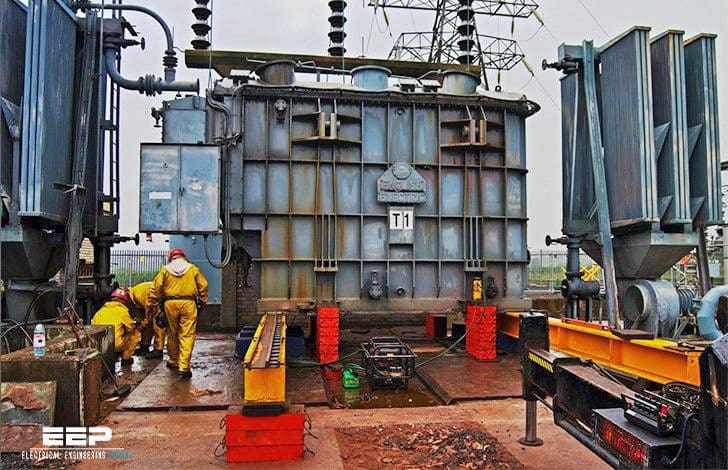Transformer protection
This guide focuses primarily on application of protective relays for the protection of power transformers, with an emphasis on the most prevalent protection schemes and transformers. Principles are emphasized. Setting procedures are only discussed in a general nature in the material to follow.

Refer to specific instruction manuals for your relay. The references provide a source for additional theory and application guidance.
The engineer must balance the expense of applying a particular protection scheme against the consequences of relying on other protection or sacrificing the transformer. Allowing a protracted fault would increase the damage to the transformer and the possibility of tank rupture with a consequent oil fire and consequent personnel safety risks.
There is no rule that says what specific protection scheme is appropriate for a given transformer application. There is some tendency to tie protection schemes to the MVA and primary kV of a transformer.
While there is some validity to this approach, there are many other issues to be considered. Issues to be considered include:
- The severity of personnel safety concerns and the possibility that a given protection scheme can reduce these risks.
- The danger to nearby structures and processes if a transformer fails catastrophically and the possibility that a given protection scheme can reduce the possibility of such a failure.
- An overall view of the economic impact of a transformer failure and what can be done to reduce the risk, including:
- The direct economic impact of repairing or replacing the transformer.
- The indirect economic impact due to production loss.
- Repair time vs. complete replacement time.
- The availability of backup power feed or emergency replacement transformers, and the cost of each option.
- The possibility that a given protection scheme can reduce the damage and resultant repair time, or that it can change a replacement into a repair.
Specific applications
Some specific applications that affect protection are:
A tap changer flashover can ordinarily be repaired in the field, but if this fault is allowed to evolve into a winding fault, the transformer will need to be shipped to a repair facility; hence, protection that can rapidly sense a tap change fault is desirable.
A high magnitude through fault (external fault fed by the transformer) shakes and heats a transformer winding, and the longer the through fault lasts, the greater the risk of it evolving into an internal transformer fault; hence, fast clearing for close-in external faults is part of the transformer protection scheme.
Slow clearing protection schemes may be unacceptable from an arc flash exposure perspective.

Fires in an indoor transformer may have high risk of catastrophic facility damage and even higher personnel safety risks, increasing the need for advanced high speed protection. The proximity of flammable process chemicals increases a need for protection schemes that reduce the risk of a tank fire.
Even the loss of a small station service transformer can cause a notable disruption of generation and high economic consequences. Similar economic impacts may also exist at industrial sites. Some transformers are custom designs that may have long lead times, increasing the need for advanced protection schemes.
Transformer Failure Statistics
Table below lists failures for six categories of faults (acc. to IEEE C37.90, “Guide for Protective Relay Applications to Power Transformers, Ref. 1):
| Failures through years | 1955-1965 | 1975-1982 | 1983-1988 | |||
| Number | Percent of Total | Number | Percent of Total | Number | Percent of Total | |
| Winding failures | 134 | 51 | 615 | 55 | 144 | 37 |
| Tap changer failures | 49 | 19 | 231 | 21 | 85 | 22 |
| Bushing failures | 41 | 15 | 114 | 10 | 42 | 11 |
| Terminal board failures | 19 | 7 | 71 | 6 | 13 | 3 |
| Core failures | 7 | 3 | 24 | 2 | 4 | 1 |
| Miscellaneous failures | 12 | 5 | 72 | 6 | 101 | 26 |
| TOTAL | 262 | 100 | 1127 | 100 | 389 | 100 |
Winding and tap changers account for 70% of failures. Loose connections are included as the initiating event, as well as insulation failures. The miscellaneous category includes CT failure, external faults, overloads, and damage in shipment. An undisclosed number of failures starts as incipient insulation breakdown problems.
These failures can be detected by sophisticated online monitoring devices (e.g. gas-in-oil analyzer) before a serious event occurs.
| Title: | Transformer Protection Application Guide – BASLER ELECTRIC |
| Format: | |
| Size: | 2.0 MB |
| Pages: | 33 |
| Download: | Here 🔗 (Get Premium Membership) | Video Courses | Download Updates |



Thnks for such agood document
very good
Thanks very much for this valuable content
Cant thank you enough for the many understanding of electrical system you have shared in this forum. keep it up, i appreciate
All articles in EEP are great. I have a question regarding some testing of 3ph,60hz, 600 volts generator to be stepped down to 400 volts.Generator rating is 1750 kva, 1225kw, 600 volts,1684amps. We need to test the genset using a 400-480 volt resistive loadbank available. Available autotransformer is 3000kva, input 480v, output 600v. What size of protection do we need in the primary side as we are connecting the input as 600 volts and output as 400v going to load bank? What is the safe cable ampacity required for primary and secondary side per phase of the transformer? Also said generator has no built in ckt breaker. thanks a lot
Thanks for sharing
many many thanks; really you are an special case in what you are doing !!! rare people like you; again thanks.
Thanks Komichi!